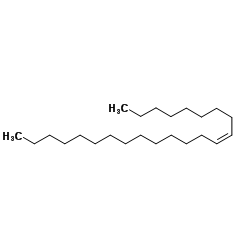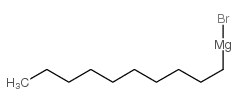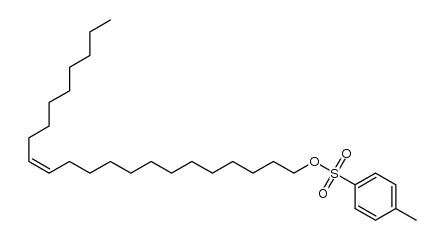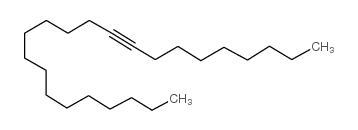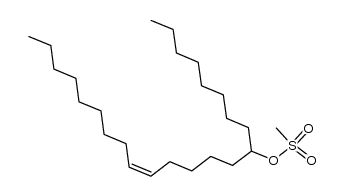27519-02-4
| Name | muscalure |
|---|---|
| Synonyms |
EINECS 248-505-7
(9Z)-Tricos-9-ene cis-tricos-9-ene MUSCAMONE Tricosene cis-9-Tricosene (9Z)-9-Tricosene tricos-9c-ene 9-Tricosene, (9Z)- MUSCALURE MFCD00008988 FLYBAIT (Z)-tricos-9-ene (9Z)-Tricos-9-en cis-9-Tricosene,Muscalure |
| Description | (Z)-9-Tricosene (cis-9-Tricosene) is an insect pheromone present in flies of the order Diptera (such as the housefly) and can be used as an insecticide[1]. |
|---|---|
| Related Catalog | |
| References |
| Density | 0.8±0.1 g/cm3 |
|---|---|
| Boiling Point | 399.4±9.0 °C at 760 mmHg |
| Molecular Formula | C23H46 |
| Molecular Weight | 322.61 |
| Flash Point | 208.8±9.7 °C |
| Exact Mass | 322.359955 |
| LogP | 12.46 |
| Vapour Pressure | 0.0±0.4 mmHg at 25°C |
| Index of Refraction | 1.453 |
| Storage condition | -20°C |
Synonym:Muscalure; (Z)-9-Tricosene; 9-Tricosene; 9-Tricosene, (Z)-; cis-Tricos-9-ene; Muscamone; Tricosen Section 2 - COMPOSITION, INFORMATION ON INGREDIENTS
Risk Phrases: None Listed. Section 3 - HAZARDS IDENTIFICATION EMERGENCY OVERVIEW
The toxicological properties of this material have not been fully investigated. Potential Health Effects Eye: May cause eye irritation. Skin: May cause skin irritation. Ingestion: May cause irritation of the digestive tract. The toxicological properties of this substance have not been fully investigated. Inhalation: May cause respiratory tract irritation. The toxicological properties of this substance have not been fully investigated. Chronic: No information found. Section 4 - FIRST AID MEASURES Eyes: Immediately flush eyes with plenty of water for at least 15 minutes, occasionally lifting the upper and lower eyelids. Get medical aid. Skin: Get medical aid. Flush skin with plenty of water for at least 15 minutes while removing contaminated clothing and shoes. Wash clothing before reuse. Ingestion: Never give anything by mouth to an unconscious person. Get medical aid. Do NOT induce vomiting. If conscious and alert, rinse mouth and drink 2-4 cupfuls of milk or water. Inhalation: Remove from exposure and move to fresh air immediately. If not breathing, give artificial respiration. If breathing is difficult, give oxygen. Get medical aid. Notes to Physician: Section 5 - FIRE FIGHTING MEASURES General Information: As in any fire, wear a self-contained breathing apparatus in pressure-demand, MSHA/NIOSH (approved or equivalent), and full protective gear. During a fire, irritating and highly toxic gases may be generated by thermal decomposition or combustion. Vapors may be heavier than air. They can spread along the ground and collect in low or confined areas. Extinguishing Media: Water may be ineffective. Use water spray, dry chemical, carbon dioxide, or appropriate foam. Section 6 - ACCIDENTAL RELEASE MEASURES General Information: Use proper personal protective equipment as indicated in Section 8. Spills/Leaks: Clean up spills immediately, observing precautions in the Protective Equipment section. Absorb spill using an absorbent, non-combustible material such as earth, sand, or vermiculite. Do not use combustible materials such as sawdust. Provide ventilation. Section 7 - HANDLING and STORAGE Handling: Wash thoroughly after handling. Remove contaminated clothing and wash before reuse. Use with adequate ventilation. Avoid contact with eyes, skin, and clothing. Keep container tightly closed. Avoid ingestion and inhalation. Storage: Store in a tightly closed container. Store in a cool, dry, well-ventilated area away from incompatible substances. Section 8 - EXPOSURE CONTROLS, PERSONAL PROTECTION Engineering Controls: Facilities storing or utilizing this material should be equipped with an eyewash facility and a safety shower. Use adequate ventilation to keep airborne concentrations low. Exposure Limits CAS# 27519-02-4: Personal Protective Equipment Eyes: Wear appropriate protective eyeglasses or chemical safety goggles as described by OSHA's eye and face protection regulations in 29 CFR 1910.133 or European Standard EN166. Skin: Wear appropriate protective gloves to prevent skin exposure. Clothing: Wear appropriate protective clothing to prevent skin exposure. Respirators: A respiratory protection program that meets OSHA's 29 CFR 1910.134 and ANSI Z88.2 requirements or European Standard EN 149 must be followed whenever workplace conditions warrant respirator use. Section 9 - PHYSICAL AND CHEMICAL PROPERTIES Physical State: Clear liquid Color: clear almost colorless Odor: None reported. pH: Not available. Vapor Pressure: Not available. Viscosity: Not available. Boiling Point: 300 deg C @ 760.00mmHg Freezing/Melting Point: Not available. Autoignition Temperature: Not applicable. Flash Point: > 110 deg C (> 230.00 deg F) Explosion Limits, lower: Not available. Explosion Limits, upper: Not available. Decomposition Temperature: Not available. Solubility in water: Not available. Specific Gravity/Density: .8060g/cm3 Molecular Formula: C23H46 Molecular Weight: 322.61 Section 10 - STABILITY AND REACTIVITY Chemical Stability: Stable under normal temperatures and pressures. Conditions to Avoid: Incompatible materials, strong oxidants. Incompatibilities with Other Materials: Oxidizing agents. Hazardous Decomposition Products: Carbon monoxide, carbon dioxide, acrid smoke and fumes. Hazardous Polymerization: Has not been reported. Section 11 - TOXICOLOGICAL INFORMATION RTECS#: CAS# 27519-02-4: YD0807000 LD50/LC50: CAS# 27519-02-4: Inhalation, rat: LC50 = >5 gm/m3; Oral, rat: LD50 = >5000 mg/kg; Skin, rabbit: LD50 = >2000 mg/kg. Carcinogenicity: cis-9-Tricosene - Not listed by ACGIH, IARC, or NTP. Other: See actual entry in RTECS for complete information. Section 12 - ECOLOGICAL INFORMATION Section 13 - DISPOSAL CONSIDERATIONS Dispose of in a manner consistent with federal, state, and local regulations. Section 14 - TRANSPORT INFORMATION IATA Not regulated as a hazardous material. IMO Not regulated as a hazardous material. RID/ADR Not regulated as a hazardous material. Section 15 - REGULATORY INFORMATION European/International Regulations European Labeling in Accordance with EC Directives Hazard Symbols: Not available. Risk Phrases: Safety Phrases: S 24/25 Avoid contact with skin and eyes. S 28A After contact with skin, wash immediately with plenty of water. S 37 Wear suitable gloves. S 45 In case of accident or if you feel unwell, seek medical advice immediately (show the label where possible). WGK (Water Danger/Protection) CAS# 27519-02-4: No information available. Canada CAS# 27519-02-4 is listed on Canada's NDSL List. CAS# 27519-02-4 is not listed on Canada's Ingredient Disclosure List. US FEDERAL TSCA CAS# 27519-02-4 is listed on the TSCA inventory. SECTION 16 - ADDITIONAL INFORMATION N/A |
CHEMICAL IDENTIFICATION
HEALTH HAZARD DATAACUTE TOXICITY DATA
|
| Symbol |

GHS07 |
|---|---|
| Signal Word | Warning |
| Hazard Statements | H317 |
| Precautionary Statements | P280-P333 + P313 |
| Personal Protective Equipment | Eyeshields;Gloves |
| Hazard Codes | Xi: Irritant; |
| Risk Phrases | R36/37/38 |
| Safety Phrases | S24/25 |
| RIDADR | NONH for all modes of transport |
| WGK Germany | 2 |
| RTECS | YD0807000 |
| Packaging Group | II; III |
| Hazard Class | 4.1 |
| HS Code | 2901299010 |
| Precursor 6 | |
|---|---|
| DownStream 2 | |
| HS Code | 2901299010 |
|---|---|
| Summary | HS: 2901299010 cis-9-tricosene Educational tariff:17.0% Tax rebate rate:9.0% Regulatory conditions:S(Registration certificate of import and export) Lowest tariff:2.0% General tariff:30.0% |

